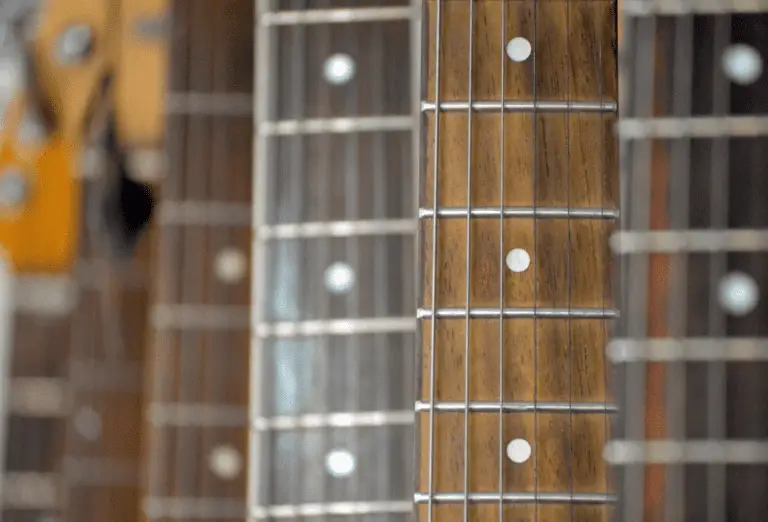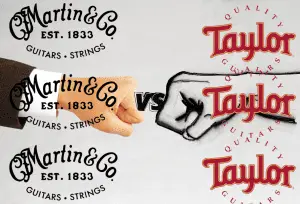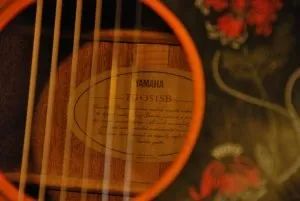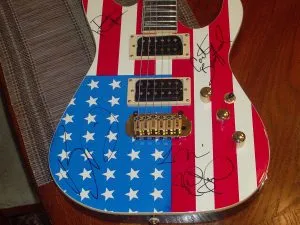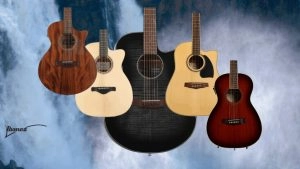If you’re new to guitar, you might wonder why guitars typically have dots on every other fret of the guitar’s neck.
What are these marks on a guitar fretboard called? What are they made from? What purpose do they serve?
These dots, also called inlays, fret markers, or fretboard markers, are designed to help you find the correct frets and notes while playing. Most guitars have fretboard dots, but in some cases, you’ll find different shapes such as stars, bars, birds, or flowers.
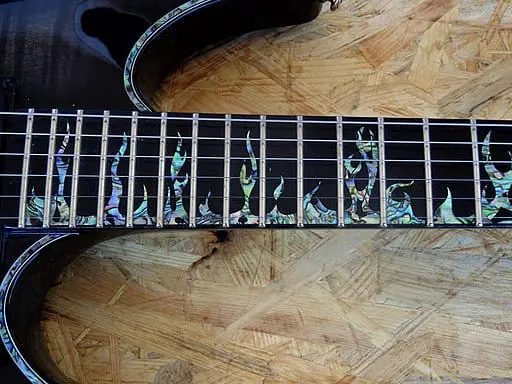
Guitar inlays come in many different shapes, sizes, and materials. Higher-end guitars might have custom inlays with elaborate designs across the frets, but they all serve the same function.
However, not all guitars have fretboard dots or markers. Some guitars go for a more minimal look—eschewing the fret markers on the front of the guitar neck for a simple dot (or double dot) on the side of the neck.
Interested in the different guitar inlays on electric and acoustic guitars? Let’s dive in and learn more about fretboard markers!
• • •
What are the Dots on a Guitar Fretboard?
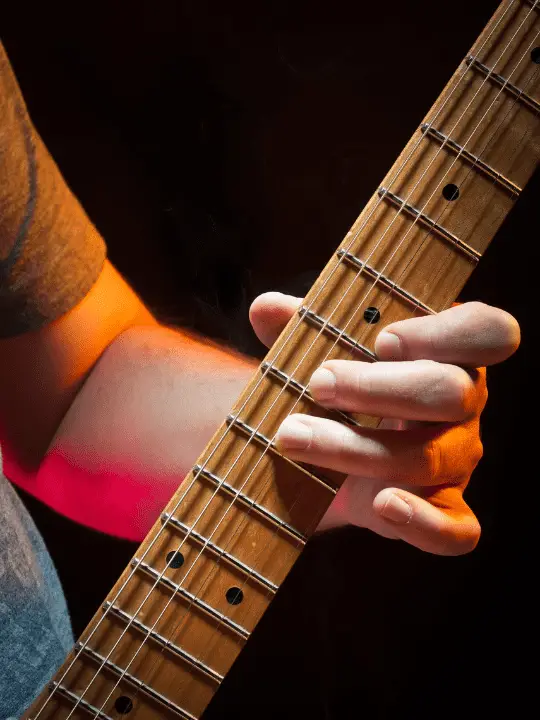
The dots on your guitar’s fretboard serve a very important purpose: helping you find the correct frets — and the right notes — on your guitar neck. The dots on a guitar serve as an easy visual reference so you can quickly and accurately move to different fret positions.
Finding your way around the guitar fretboard can feel like learning a new language if you’re just starting out and learning how to play the guitar. Think of these fret markers as your translators. Before you know where to find a G note, identifying and finding the third fret marker might be quicker (and easier).
Over time, you’ll learn the corresponding notes and chords that come with certain fretboard marker positions. With practice, you’ll find that your hands develop some muscle memory and easily find the correct frets for chords and single notes. This will help you learn how to play more challenging riffs and chord progressions over time.
If you’re having a hard time committing fret markers and notes to memory, don’t fret! Use these fret dots as a visual aid as you start playing guitar.
Dots vs Fretboard Markers vs Inlays: What’s The Difference?
If you’ve been shopping for guitars online, you’ve probably seen the terms dots, fretboard markers, and inlays used almost interchangeably in product descriptions. So, is there a difference between dots, fret markers, and inlays on guitar fretboards?
Functionally, the answer is no — these markers all serve the same general purpose. However, you’ll find that different brands have their own signature styles regarding fretboard markers, inlays, or dots on a guitar.
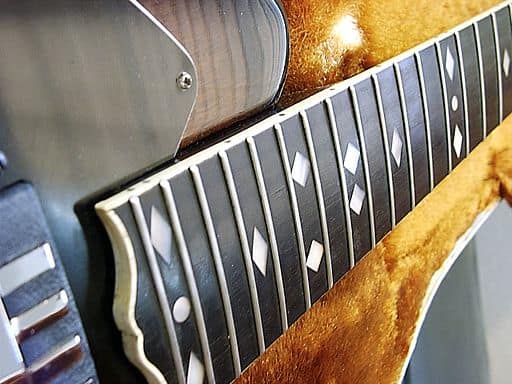
Dot markers are generally the most common type of fret marker that you’ll find. Look a little closer, and you’ll notice that these white dots on the fretboard can come in various materials.
The most common types of dot position markers include mother of pearl and abalone, but some fret markers can be made from exotic woods.
When you see the term “fretboard markers,” it’s really more of a one size fits all term that encompasses all of the different shapes and designs you’ll find on a fretboard. This can include dots, block inlays, or other shapes.
Inlays are another interchangeable term, but it’s generally used for bigger or more elaborate designs than a simple fret dot. We’ll take a deeper dive into the more elaborate inlay designs that you’ll find on PRS guitars and Jackson guitars later in this article.
You might be wondering: can I add my own inlays? What if I put a sticker on my fretboard? A quick search online will turn up a variety of guitar fretboard markers that you can stick on yourself.
This can be a quick and easy way to change the color of your dots or add new guitar inlays altogether. Many of these adhesive guitar fretboard markers are removable, so you can easily revert to your original fretboard markers.
• • •
Typical Fretboard Markers Locations
On most electric guitars and acoustic guitars, you’ll find dots or fret markers on the third, fifth, seventh, ninth, twelfth, fifteenth, seventeenth, nineteenth, and twenty-first positions on the guitar fretboard.
On most guitars, there is no fretboard marker on the first fret. Instead, the first marked fret is generally the third fret. There’s really no advantage to having a marker on the first fret — since the first fret is arguably the easiest to find without looking, it’s more of an aesthetic addition.
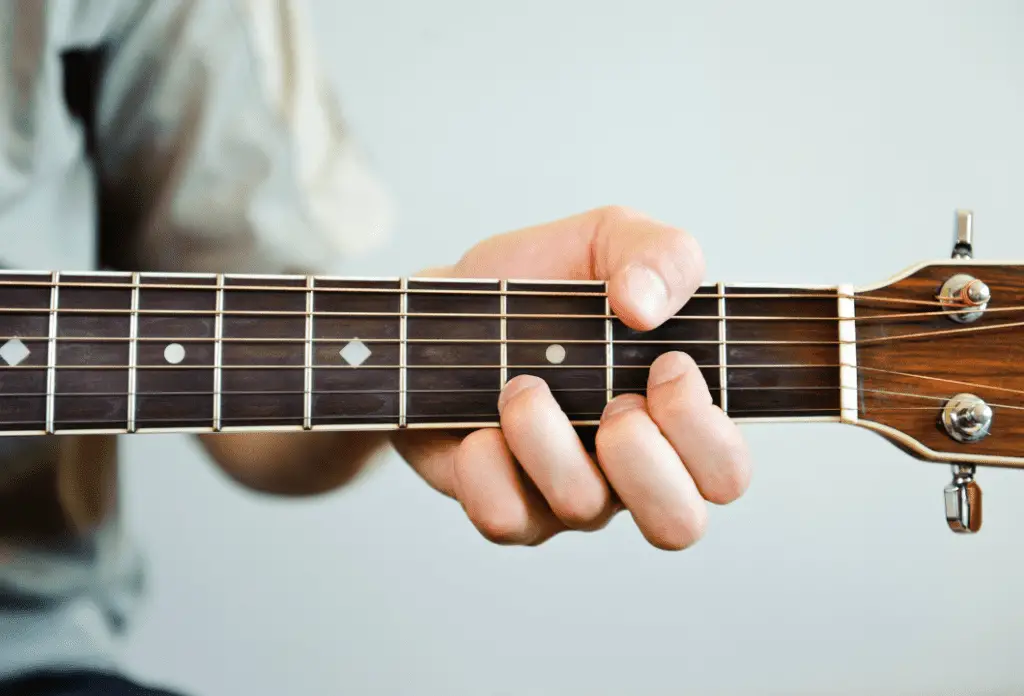
From there, the fret markers alternate on every other fret until you reach the 9th fret, 12th fret—where are two dots, one on each side of the 12th fret—and 15th fret
So, why are there two dots on the 12th fret? The 12th fret typically has a double dot (or similar) design. These two dots denote where notes start repeating on a string. It also serves as an important benchmark for correct intonation.
To illustrate this on your low E string: If your guitar is intonated properly, strumming an open E string will match the pitch of an E note on the 12th fret. In short, playing a note as an open string and at the 12th fret should sound exactly the same — just an octave higher.
Going up the entire fretboard to the 15th through 21st frets, the fretboard markers will resume the every-other-fret pattern. Remember how a note played at the 12th fret will be the same as an open string? Think of the double dots on the 12th fret as the location where the neck starts over, and the notes repeat.
Using standard tuning as an example, the 15th fret will be the same note an octave higher (G) as the 3rd fret; the 17th fret will be the same note an octave higher as the 5th fret (A); and so on. Lead guitar players often go up into these upper octaves for solos and riffs. The second octave unlocks a new world of tones for you.
• • •
How Guitar Dots Can Help You Memorize the Fretboard
This may sound a bit overwhelming to beginners and newer guitar players, but remember that these dots on the fretboard help you. Once you start to understand which note lives on any given fret, like the 7th fret, for example, you’ll be able to easily play barre chords and riffs.
Want to start putting it all together and learn how to play some open chords or a chord progression? I’ve been playing for a long time, but I still use the internet as my go-to learning resource when I’m in a rut or trying to learn something new. Don’t be afraid to dig in and do some online learning.
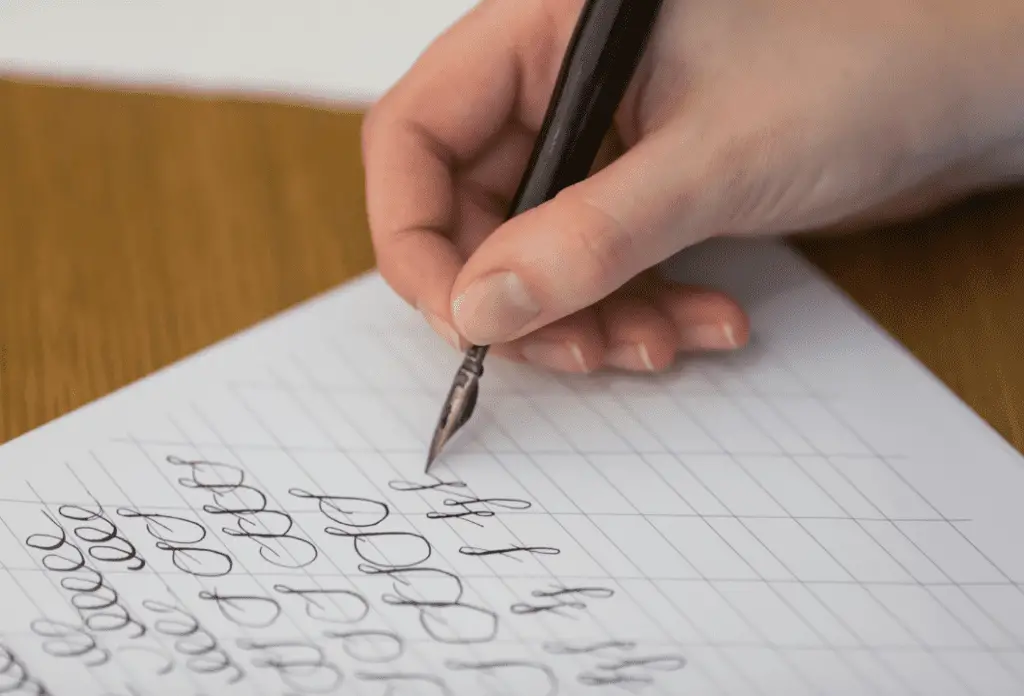
The key to memorizing the fretboard on acoustic and electric guitars is repetition. Learning how to play the guitar can take a lot of practice and time. Once you start to memorize the fretboard, you’ll discover that you can play the same notes in two locations on any particular string.
Remember that the double-dot inlay on the 12th fret is where notes start repeating from open strings. If you’re playing a note on your D string, you can play a D with an open string or on the 12th fret. Visual reminders like that make it easy for me to find where I need to be on the fretboard.
Don’t get frustrated. Take your time, develop a good practice routine, and most importantly, have fun uncovering new sounds as you explore the fretboard. We always recommend signing up for some online guitar lessons to really develop your fretboard mastery.
From there, don’t be afraid to experiment and try new things. Learn a major scale. Learn how to play harmonics. Try playing a riff or a scale at an octave higher. If you get stuck, try something new, and you might be surprised at the inspiration and motivation you’ll uncover.
• • •
Famous Custom Fretboard Inlays
For some brands, the style of their fretboard markers is as recognizable as the guitar itself. While some inlay designs simply consist of dots on the fretboard, other brands opt for more intricate and elegant designs.
Paul Reed Smith Inlays
Paul Reed Smith guitars, with their trademark bird inlays, are a great example of how inlays can make a guitar brand instantly recognizable. The story behind the birds is actually pretty simple. “My mother was a bird watcher,” said Paul Reed Smith (1), and he often joined his mother and family on bird-watching excursions.
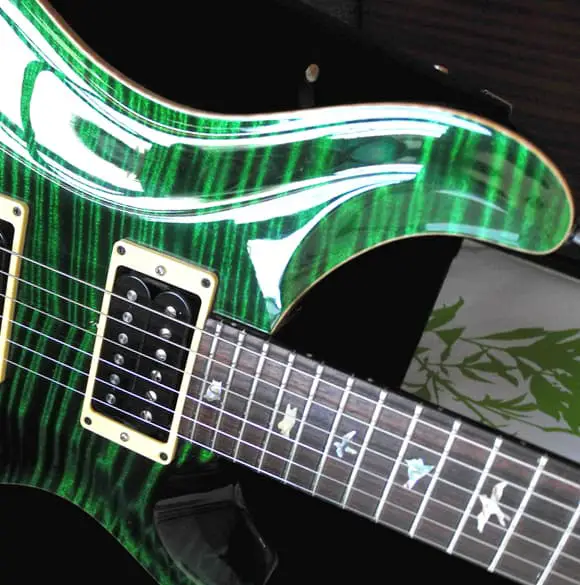
Over the years, Paul Reed Smith guitars have featured a number of subtle variations to their trademark bird designs. Some guitar inlays feature outlines of the birds, brushstrokes, or more abstract versions.
According to PRS, “bird inlays have experienced several re-draws and artistic variations, but the foundation of Paul’s original designs has remained consistent.”
Paul Reed Smith guitars, and by extension their custom inlays, have attracted a flock of fans over the years. So much so that PRS has dedicated a page on their website to some of their fans who have tattoos of the famous bird designs (2).
Gibson Inlays
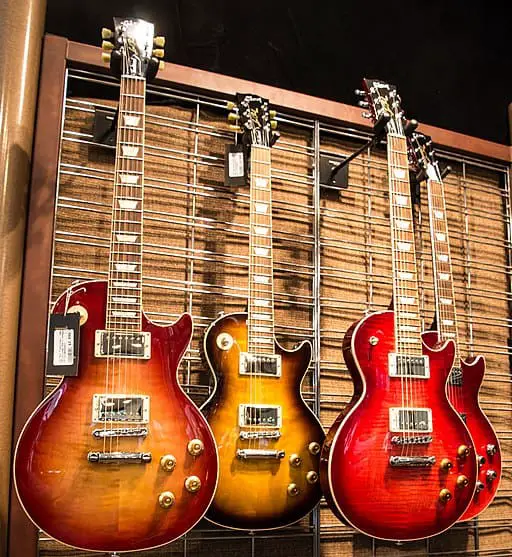
Gibson guitars are perhaps best known for two primary inlay designs: block inlays and trapezoid inlays. These inlays are most commonly found in Les Paul and hollow body guitar styles. Some models feature scaled-down versions of these inlay shapes in vintage reissue models.
On the higher end, Gibson employs a “split-block” design on an assortment of their vaunted Custom Shop guitars. This design essentially draws 1-2 diagonal lines across glittering block-style inlays.
Another style found on a handful of Gibsons ES and acoustic guitar models is the split parallelograms. I’ve never owned one, but these guitar inlays are the best looking, in my opinion.
Some of Gibson’s lower-end models also include the basic “dots on a guitar” fretboard pattern, but most models feature one of their more intricate designs.
Fender Inlays
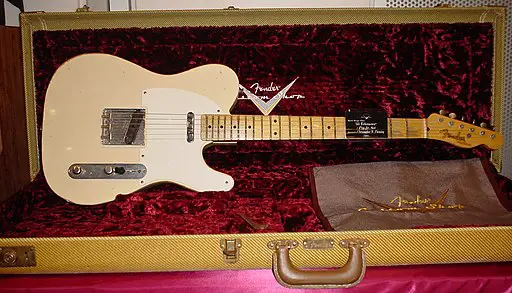
To be honest, there’s not much to say about Fender inlays. That’s because most of Fender’s product line features simple dot fret markers.
That’s not to say that Fender hasn’t deviated from that design motif over the years. Some Fender guitar models such as the Jazzmaster, Coronado, and Custom Shop Stratocasters have employed block inlays over the years.
Jackson Inlays

Jackson guitars are best-known for their “shark fin” style inlays. These sharp, angular inlays came in an assortment of sizes and alignments, but many of Jackson’s modern models employ a variation of this inlay style made popular in the 1980s.
Tree of Life Inlays

Perhaps best known for being a standout feature in Steve Vai’s line of signature Ibanez guitars, the Tree of Life inlay style has roots in older banjos and acoustic guitars.
A handful of Martin acoustics feature this same pattern, but those acoustics are anything but cheap. If you want the Tree of Life without taking out a second mortgage, you can pick up a sheet of stickers for around $20.
• • •
What Are Guitar Inlays Made Of?
Guitar inlays are often made from mother of pearl, plastic, and wood. However, you can find inlay materials from both the high and low ends of the spectrum.
Some inlays are constructed from exotic woods or even LED lights. On the lower end, you can purchase a sheet of stickers that you can adhere to your fretboard to add a customized look to your guitar.
• • •
Why Are There No Fret Markers on Classical Guitars?

Classical guitars are unique in that there are no visible markers on the fretboard. Instead, some classical guitars include side dots where you can get a quick visual reference of where you are on the fretboard. Some classical guitars feature a marker at the 7th fret. This is because the 7th fret gives you a perfect 5th interval from an open string.
So why are there no fret markers on classical guitars? There are a couple of common theories. For one, classical players are typically taught to “sight read” written music and play without looking at their hands.
Second, it’s the way they’ve always been made. That doesn’t stop players of all skill levels from adding their markers, at least to the side of their necks, to get a quick visual representation of where they are on the fretboard.
• • •
Fret Not, Inlays Are Here to Help You
Whether you’re brand new to guitar or a seasoned player, fret markers exist to serve one crucial purpose: helping you find the right place on the fretboard.
Regardless of experience and skill, players need to find the correct position on the correct guitar strings to play everything from simple barre chords to blistering solos.

There are a variety of popular inlay designs, from simple dots to intricate tree branches. Other guitars feature high-end materials on their frets, but they all serve the same purpose.
Even guitars without visible fret markers, such as classical guitars, will feature side dots or a simple marker at the 7th fret.
Most guitarists prefer to have at least a guidepost or two on their frets to help them find their way. Look to the two dots on the 12th fret like a beacon in the night if you ever get lost.
Now that we’ve covered all the different inlay designs you’ll find on most guitar frets, which style do you like best?
The different types of inlays won’t necessarily make one guitar better than another, but they can be an additional motivating factor for deciding which style of guitar you like best.
• • •
References:
- “The Story of the PRS Bird Inlays” as published here https://prsguitars.com/blog/post/the_story_of_the_prs_bird_inlays
- “Devoted Fans and Their PRS Tattoos” as published here https://prsguitars.com/index.php/blog/post/tat_tuesday_devoted_fans_and_their_prs_tattoos
Image Credits:
Schecter Hellraiser Flame Limited Edition fret markers & inlay image: Monika Fischer, CC BY-SA 2.0, via Wikimedia Commons; Ovation Deacon Fretboard Inlay and Binding image: Timpraetor, CC BY 3.0, via Wikimedia Commons; PRS inlays image: fvancini, CC BY 2.0, via Wikimedia Commons; Gibson guitars image: Michael Gaylard from Horsham, UK, CC BY 2.0, via Wikimedia Commons; Fender Telecaster image: CasinoKat, CC BY-SA 3.0, via Wikimedia Commons; Jackson guitars image: Paulo Guereta from São Paulo, CC BY 2.0, via Wikimedia Commons; Ibanez JEM70V-SFG Steve Vai Signature image: ArtBrom from Seattle, CC BY-SA 2.0, via Wikimedia Commons; Di Giorgio classic guitar image: No machine-readable author provided. Evil berry assumed (based on copyright claims)., CC BY-SA 3.0, via Wikimedia Commons.

